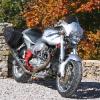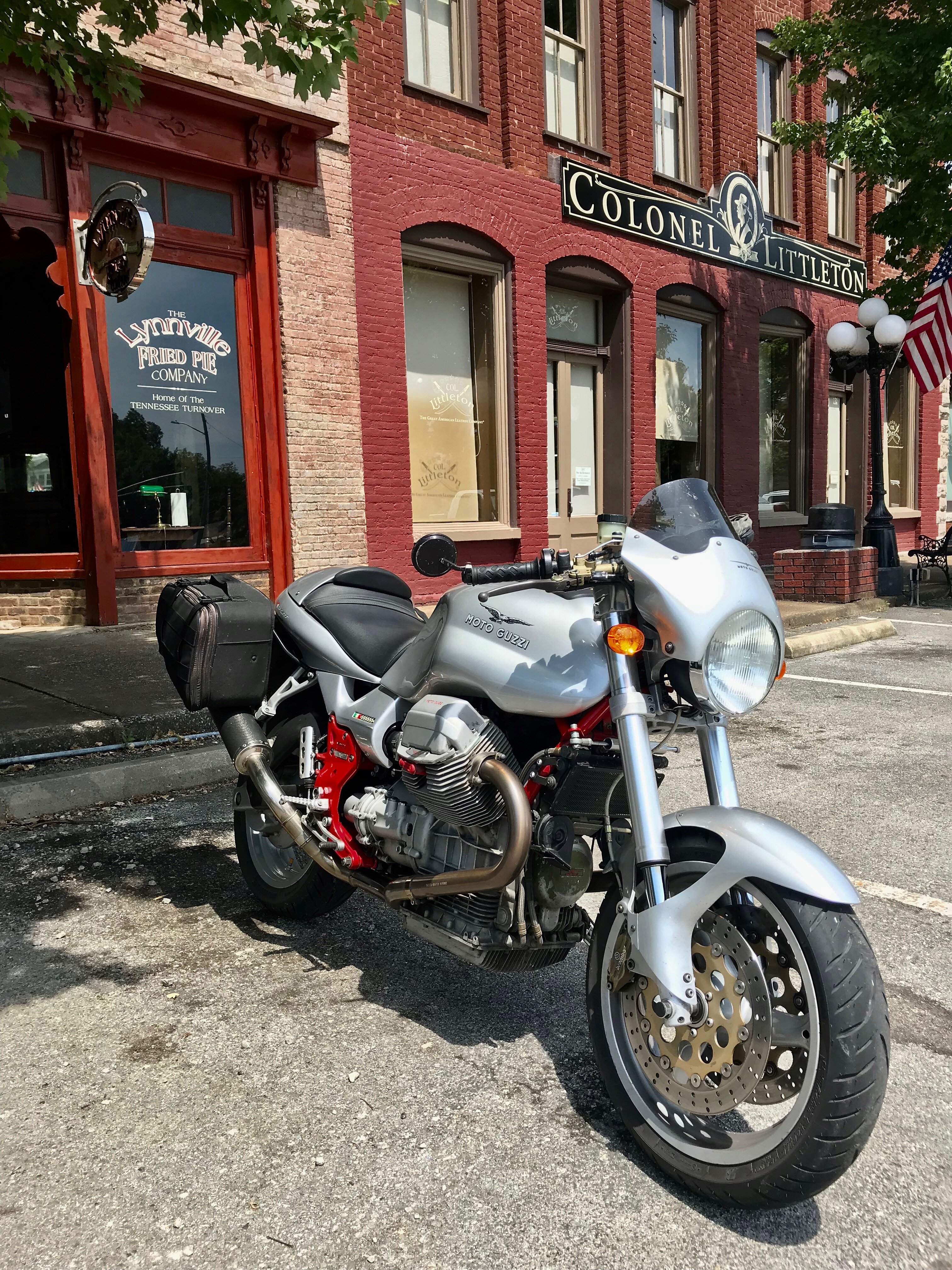-
Posts
20,491 -
Joined
-
Last visited
-
Days Won
1,188
Content Type
Profiles
Forums
Events
Gallery
Community Map
Everything posted by docc
-
Sean, Can you check the battery voltage out of the bike with a digital volt meter? I know you said its a new battery, but. . . Also, time to pull the ignition switch and have a look at the contacts for anything unseemly.
-
b'lee, The battery ground wire is bolted to the back of the gearbox above the drive shaft output. Good place to do a clean and lube while being sure the terminal stack on the battery is also clean and tight (most of the wiring harness earths back to the terminal stack). Yes, ground the regulator from its case back to the timing chest. Again, be sure to clean the surfaces (including paint) and apply some weather protection (dielectric grease, Vaseline, KY jelly . . . what ever is, er, 'handy' ). Also consider adding a ground from the frame to the engine. I used the same timing chest bolt as the regulator ground and went to the bracket for the fuel filter on the right side of the frame above the valve cover on my Sport. I did this since I've grounded my horn relays and headlamps back to the frame.
-
Speedhut printed "Moto Guzzi" on your gauge faces? Nice touch . . .
-

any questions on Holland / the Netherlands ?
docc replied to Admin Jaap's topic in Special place for banter and conversation
Hilarious! No wonder there might be "some confusion!" It all makes the electrical system on my V11 seem perfectly sensible and well thought out . . . -
Haha! Jason and 2005 to the rescue!
-
Looks like the previous owner installed a manual petcock and that is the connector for the original electric fuel petcock. No harm letting it be although I removed the fuse for that circuit for good measure. (Fuse 8/ 5 amp) Be sure the loose connector won't hang down and foul the throttle or touch the head.
-
All of my Angel STs lasted the same mileage as the previous Diablo Stradas. It will be interesting to see if the new GTs do better without being too hard (like Pilot Roads)
-
Ken, How many miles on your Sport when you sent the injectors off?
-
Really shouldn't take much to bring her around: fluids, tires, a tune-up? Maybe a battery - surely not thousands!
-
From Colin Chapman, of Lotus cars, "Simplify, then add lightness." Thank you for citing the reference for me! A great man, Mr. Chapman... The anecdote that Chapman would remove frame bracing until the frame collapsed, then add the last one back in reminds me of Greg Field's account of Wittner's development time at Moto Guzzi placing the front wheel against the wall and driving the bike against it til something broke, then beefing up that part. (I'm paraphrasing pretty deeply here).
-
"Piqued" is such a great word. But pales in contrast to "edge a macation." Apologies to international translation.
-
From Colin Chapman, of Lotus cars, "Simplify, then add lightness." I always think the Guzzi could benefit from that. She is sometimes like dancing with a very beautiful, but heavy, woman on high heels.
-
So, GA, how many miles on the Sport? What are you thinking of done to her? BTW, congratulations on the new addition!
-
And, here, we have traced Guzzi's roots back to its origin: WWI; Guzzi, Parodi, Ravelli
-
Those with tasteful grigio Sports might call THAT green: Bug-Splat, but only from the relative safety of a sequestered laptop. Never in a parking lot, or in the proximity tire irons. Oh, seriously, that's a stunning color: V7 Sport Telaio Rosso Green Several of us have bodged our way through he Tekno mounts, and there is more than one way to get them as you wish. I ended up shortening the sleeves that index the offset and put my bag mounts inboard of the muffler brackets to compact the profile. We have a pretty good thread on that here somewhere. I'll see if i can find it (has pictures). EDIT: Here's a 2006 thread- Tekno Bags???? (Moderator note: When searching, search by "replies" for best results. And, by no means, let the The Search Function stop you from posting and having active, current threads. Resurrecting an old thread, even from 2006, is OK - good even.
-
I logged in today to pin this thread and see it already done. Thanks -well done!
-
This is so incredible! Paul, you are amazing! I've lost track of how many biers I owe you!
-
You're pulling your pork chops for why? Be sure the measure how much the mounting pins stand off the surface, with the lock nuts removed, with a dial caliper before disassembly. Otherwise, your heart can sink when you get to the line in the manual that says, "reassemble using the measurements you took (or didn't!) before disassembly." Also, I presume you serviced all the connectors under the tank especially the flinky two bullet connectors on the left side for the clutch switch. Good time to inspect those plug wires at the coils.
-
Whoa - that is some Texas-green-funk there! th'Bronze: did you just spray it with contact cleaner or what? (BTW, when you're in that close, carefully inspect the two yellow wires leaving the stator. One is prone to breaking and very hard to see.)
-
The Coppa with the damage was from Arizona which also surprised me. We think of these things as long winter storage issues. No doubt, the battery is first thing to check, although I don't remember them blowing the ignition switch fuse. I presume you mean Fuse 4? My 2000 Sport has a 10 amp in the #4 position (ignition switch). Some chance the previous owner upped the fuse size to solve a problem short in the circuit?
-
Funny, I went back upstairs to finish reading Peter Egan's column, Leanings, in February's Cycle World in which he names each month by the moon related to motorcycling. He calls January, "The Moon When Mice Eat Your Wiring Harness and Put Corn Nuggets in Your Air Cleaner."
-
Not long ago, I helped sort a beautiful Coppa Italia that had some telltale signs of rodent damage. The PO had replaced one section of wiring entirely that ended up all melted. Just because the bike's been put up doesn't mean nothing has happened to it. Have a close inspection of all the wiring you can see.
-
I don't remember the ignition switch being hard to access, although I can't find a reference for that. I think it was pretty easy to get to and clean up per Kiwi Roy. Good medicine -a "Must Do." I just looked at my breather hose junction at the crankcase (84,000+ miles) and it looks a little hazy, maybe. Not enough to get all disturbed about it. Maybe they are climate sensitive. Dunno.
-
From the pictures of the hoses side by side, it doesn't look like it needs any bending, just trimming. Yet, a quick search showed most sources are $20-25US, although there was one for $10.90. Not a huge savings, but the heater hose may be a bit more durable. Notable that the picture shows the Guzzi part for an EV, not a spine frame, yet spine frame owners at the time reported simply trimming it to fit. Better link here directly to the picture. Ken, Thanks for the reminder on the valve. I completely forget it is there!
-
I recall there is a fitment using a heater hose for a Ford. I'll start the battle with the search and see what I can turn up . . . There it is (search by "replies"): Breather Hose Replacement from 2006


